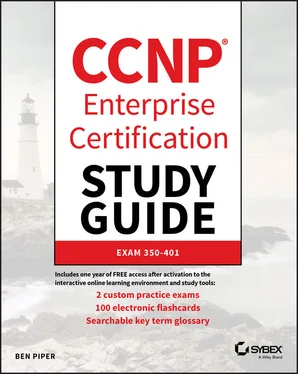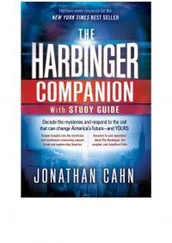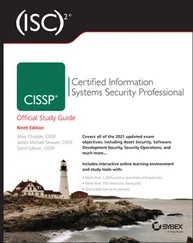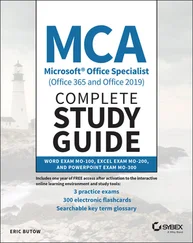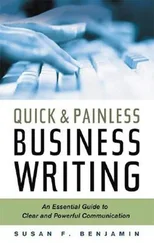3 B, D. Transmission Control Protocol (TCP) uses sequence numbers for ordering and ensuring reliable delivery by detecting lost packets. See Chapter 1 for more information.
4 A, B. You can block VLAN 25 from reaching the switches in two ways. First, you can prune the virtual LAN (VLAN) from the trunk. Second, instead of running a trunk between switches, you can use routed links. See Chapter 2 for more information.
5 D. Because SW1 and SW2 are connected via routed interfaces, they are in separate broadcast domains and hence form separate Spanning Trees. See Chapter 2 for more information.
6 C. Loop Guard will block a VLAN on a port if it doesn't receive Bridge Protocol Data Units (BPDUs) for that VLAN. Unidirectional Link Detection (UDLD) and BPDU Guard can shut down an entire port. BPDU Filter doesn't block traffic. See Chapter 2 for more information.
7 B. Leaf-and-spine architecture is the most scalable choice for networks with predominantly East-West traffic patterns such as data center networks. Routed is not a physical architecture, but rather a layer 2 architecture. See Chapter 3 for more information.
8 A, D. Routed topologies scale better and converge faster than switched topologies, but they require consuming more IP address space. See Chapter 3 for more information.
9 B. EtherChannel doesn't use multicast. Link Aggregation Control Protocol (LACP), which negotiates EtherChannels, and Virtual Router Redundancy Protocol (VRRP) and Hot Standby Router Protocol (HSRP), which are first-hop redundancy protocols (FHRPs), do use multicast. See Chapter 3 for more information.
10 A. An access point (AP) forms a single Control and Provisioning of Wireless Access Points (CAPWAP) tunnel with a wireless LAN controller (WLC). See Chapter 4 for more information.
11 C. In an intracontroller roam, the client associates with a different AP that's connected to the same WLAN controller. Neither the VLAN nor the Service Set Identifier (SSID) changes. Because the client's IP address didn't change, you can conclude this is a layer 2 roam. See Chapter 4 for more information.
12 A, C. 5.4 GHz Wi-Fi standards include 802.11n and 802.11ac, but not 802.11g. 5.4 GHz offers higher throughput, but at the price of increased free space path loss. See Chapter 4 for more information.
13 B. The first Open Shortest Path First (OSPF) router to become active on a subnet becomes the designated router (DR) for the subnet. It's commonly taught that the DR is chosen based on the highest router ID, but the first OSPF router to become active always becomes the DR. A DR election occurs only when the existing DR and backup DR fail. See Chapter 5 for more information.
14 B, C. Network types don't have to match in order to form an adjacency, but they do need to match in order for the routers to exchange routes. See Chapter 5 for more information.
15 D. When an interface is configured as a passive interface, OSPF will advertise the prefix for that interface, but will not form an adjacency with other routers on the subnet. See Chapter 5 for more information.
16 C. The route is an external Enhanced Interior Gateway Routing Protocol (EIGRP) route, so it has an administrative distance of 170. See Chapter 6 for more information.
17 A, B. By default, only bandwidth and delay are used in calculating the metric. See Chapter 6 for more information.
18 B. 10.0.56.6 is the feasible successor. See Chapter 6 for more information.
19 C. Border Gateway Protocol (BGP) uses the autonomous system (AS) path for loop prevention. Upon receiving a route with its own AS in the AS path, an exterior Border Gateway Protocol (eBGP) router will discard the route, meaning it won't install it in its BGP Routing Information Base (RIB) or IP routing table, nor will it advertise the route. See Chapter 7 for more information.
20 A. 172.16.0.0/24 doesn't exist in R1's routing table, so the network command will have no effect. Instead, the redistribute eigrp 16 command will redistribute the 172.16.0.0/16 prefix into BGP with an incomplete origin type. See Chapter 7 for more information.
21 C. The prefix list matches any prefix with a subnet falling into the 10.0.0.0/8 range with a prefix length from 8 to 32. This includes 10.0.0.0/8, 10.0.0.0/32, and 10.255.255.0/24. The first sequence in the route map is a deny sequence that matches the IP prefix list. Hence, these prefixes will match the sequence and will be denied. The second sequence in the route map is a permit sequence that matches all prefixes that don't match the first sequence. See Chapter 7 for more information.
22 A. R2 is translating the source address 7.0.0.12 to 2.0.0.2; therefore 7.0.0.12 is the inside local address and 2.0.0.2 is the inside global address. See Chapter 8 for more information.
23 C. Multicast RIB entries take the form (source, group). The entry indicates that the source—223.3.2.1—has sent multicast traffic to the multicast group address 239.8.7.6. See Chapter 8 for more information.
24 D. Port address translation—also known as network address translation (NAT) overload—translates multiple inside local source addresses to a single global address. The global address can come from an outside interface or from a pool. See Chapter 8 for more information.
25 B. CS1 gets a lower priority than CS0. CS0 is the default class and is for best-effort traffic. CS1 is the bottom-of-the-barrel traffic that you may not even want on your network, such as torrents, gaming, or cat videos. See Chapter 9 for more information.
26 A, C. TCP global synchronization occurs when multiple TCP flows back off, then ramp up simultaneously. This can happen when a queue fills and excess packets are tail-dropped. Weighted random early detection (WRED) randomly drops packets as the queue fills. Explicit congestion notification (ECN) works by getting a TCP sender to slow down the rate at which it sends by reducing its congestion window. See Chapter 9 for more information.
27 A. The low-latency queuing (LLQ) is serviced before any other queues, so packets in the LLQ won't wait any longer than necessary. The LLQ has a limited bandwidth. See Chapter 9 for more information.
28 D. The term edge virtual bridging (EVB) describes using a physical switch to pass layer 2 traffic between VMs running on the same host. The IEEE 802.1Qbg standard calls this reflective relay. See Chapter 10 for more information.
29 B, C. Internet Key Exchange (IKE) uses User Datagram Protocol (UDP) port 500, whereas Encapsulating Security Payload (ESP) uses IP protocol 50. See Chapter 10 for more information.
30 A, C. By default, Virtual Extensible LAN (VXLAN) uses multicast to flood unknown unicasts, allowing it to perform data plane learning. See Chapter 10 for more information.
31 C. SD-Access uses VXLAN encapsulation because it can carry Ethernet frames. The others can't. See Chapter 11 for more information.
32 B. Software-defined networking in a wide area network (SD-WAN) doesn't use BGP. See Chapter 11 for more information.
33 A. When authenticating using a GET or PUT request, you should get a 200 response code if authentication succeeds. See Chapter 11 for more information.
34 A. Terminal Access Controller Access-Control System Plus (TACACS+) supports authorization, authentication, and accounting. Remote Authentication Dial-In User Service (RADIUS) doesn't support command authorization. See Chapter 12 for more information.
35 C. MAC authentication bypass is the only option that can authenticate a machine but not a user. See Chapter 12 for more information.
36 A, D. You can't use a port access control list (ACL) to block certain control plane traffic, including ARP and Spanning Tree BPDUs. You also can't use an extended IP ACL because ARP and Spanning Tree Protocol (STP) don't use IP. See Chapter 12 for more information.
Читать дальше
